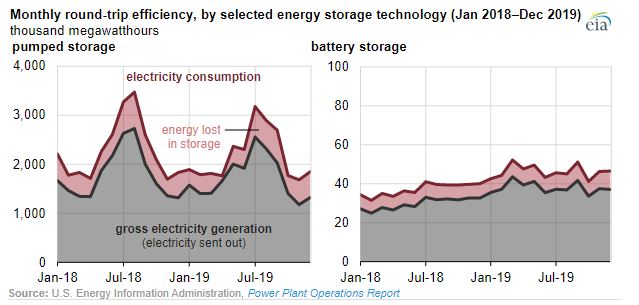
Pumped-storage hydroelectric facilities in the U.S. operated with an average monthly round-trip efficiency of 79%, and the utility-scale battery fleet operated at 82%, according to 2019 data from the U.S. Energy Information Administration (EIA).
Round-trip efficiency is the percentage of electricity put into storage that is later retrieved. The higher the round-trip efficiency, the less energy is lost in the storage process.
With electric energy storage becoming more important as the share of intermittent generating technologies, such as wind and solar, in the electricity mix increases, EIA said storage metrics can help us understand the value of the technology. EIA’s Power Plant Operations Report provides data on utility-scale energy storage, including the monthly electricity consumption and gross electric generation of energy storage assets, which can be used to calculate round-trip efficiency. The metrics reviewed here use the finalized data from the Power Plant Operations Report for 2019 — the most recent year for which a full set of storage data is available.
Pumped-storage facilities are the largest energy storage resource in the U.S. The facilities collectively account for 21.9 GW of capacity and for 92% of the country’s total energy storage capacity as of November 2020.
In recent years, utility-scale battery capacity has grown rapidly as costs have decreased. Batteries have become the second-largest source of electricity storage. As of Nov. 20, 2020, utility-scale battery capacity had 1.4 GW of operational capacity. Another 4 GW of battery capacity is scheduled to come online in 2021, according to EIA’s Preliminary Electric Generator Inventory.
Although battery storage has slightly higher round-trip efficiency, pumped-storage facilities typically operate at utilization factors that are twice as high as batteries. Increasing durations among battery applications could shift battery operations toward services that reward longer output periods. For example, in 2015, the weighted average battery duration was a little more than 46 minutes, but by 2019, weighted average battery durations were 1.5 hours.





